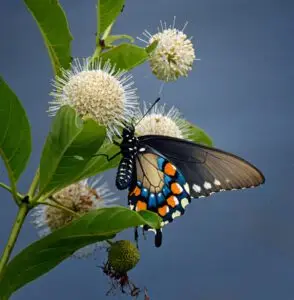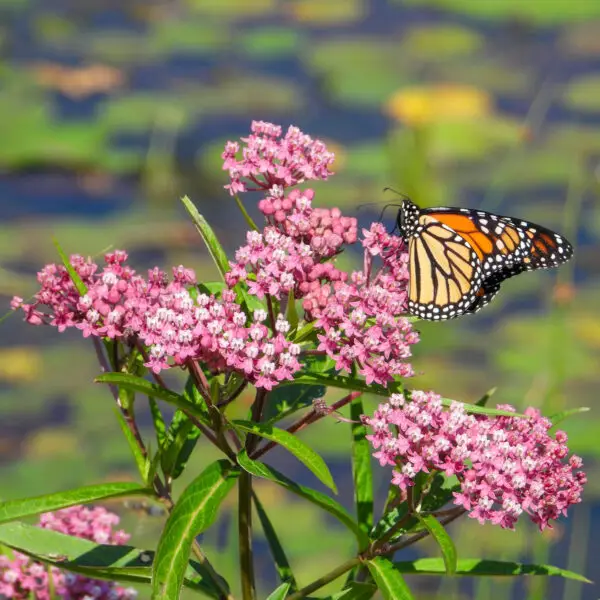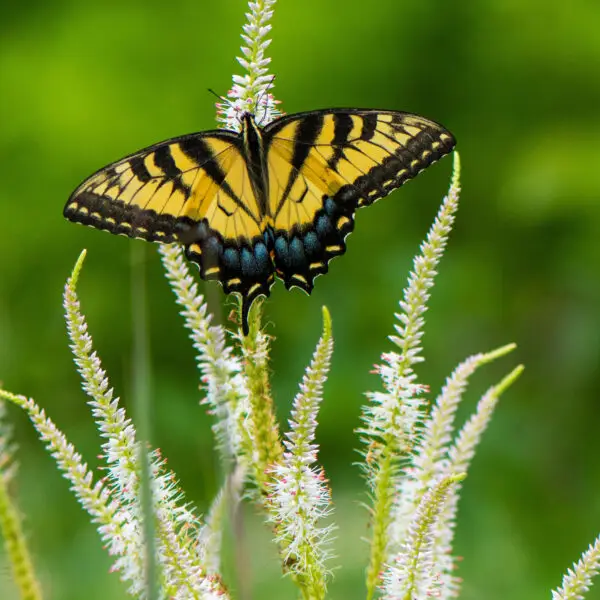What are the best native plants for a rain garden?
Do you have an area that collects water after it rains? It’s time to plant a rain garden! Downslopes, drainage ditches, and even spots underneath gutters all work well for rain gardens and water-loving native plants.
In past years, rain gardens have received a lot of landscaping attention from cities, governments, and homeowners as we navigate climate change. Having plants that suck up water during extreme weather is a huge landscaping asset.
As you plan your rain garden, choose native plants. Dozens of native plants don’t mind getting their feet wet, require minimal care, and look gorgeous. Scroll on to meet options that check all these boxes.
As you look at that muddy spot in your yard and plan a rain garden, you may consider planting a mix of non-native and native plants. Let’s briefly touch on the benefits of planting native in your rain garden, and then introduce 10+ native plants to consider.
Why plant a native rain garden?
Planting native plants is a no-brainer for homeowners. Native plants thrive with minimal attention when grown in their home area with their preferred light. When you compare planting native gardens to lawns or non-native plants, the benefits are clear:
- Native plants save water: after the first year of getting established, native plants are happy with just rain
- Native plants save time: cut down on mowing and fertilizing and plant native! Leave flowering native plants alone in the fall and winter and watch them turn into nature’s birdfeeders.
- Native plants feed butterflies and birds: all the iconic creatures we love—Monarch butterflies, hummingbirds, songbirds—depend on native plants to survive.
Native vs. non-native vs. lawns
Compare this to lawns (weekly mowing, watering in the summer) and non-native plants (fertilizing, pruning, watching out for strange diseases) and it’s easy to see why planting native is the best decision you can make when it comes to landscaping. If native plants can plant themselves for thousands of years, we can too—and use their easygoing nature to our advantage.
Now that we’ve discussed the benefits, here’s a tip as you pick rain garden plants:
Think of *how* wet an area gets as you plant
The name “rain garden” encompasses many water situations. Some rain gardens are deep and hold water for multiple days after storms, while others are shallower areas that drain once the rain lets up.
There are native plants for both situations. Some thrive in 6+ inches of water for a week, while other native plants would be in danger of root rot. How do you pick the right plants for your rain garden?
Enter rain garden ‘Zones’
To help address these different needs, landscape architects and gardeners have developed ways to describe and identify plants best suited for these situations. Let’s simplify this system to help us plant native (we’re adapting this from Penn State Extension):
- Wet Zone. An area that can hold 6+ inches of water for several days.
- Middle Zone. An area that holds several inches of water during and immediately after a storm.
- Transition Zone. This is almost your standard garden. It’s for areas adjacent to rain gardens; it will hold some water during significant storms but dries out quickly.
To further help, we’ve organized the native plants below into these zones.
Now, let’s meet some rain garden plants!
Native plants for wet zones
These native plants don’t mind sitting in 6+ inches of water for several days.
Buttonbush
These beautiful shrubs offer greenery in the spring and bright white pom-pom flowers in the summer into fall. These flowers are butterfly favorites—especially when you plant in full sun—because butterflies can eat and warm up while resting on the white orbs. Buttonbushes are excellent shrubs for waterlogged spots.
Cardinal Flower
This is a stunning and unique plant! Cardinal Flowers send up tall stalks in the early summer and then cover them with a runway of bright red flowers. The individual flowers are shaped to match hummingbird beaks perfectly. It’s almost impossible to plant Cardinal Flowers and not see hummingbirds zipping by in the summer—plant 4+ in your rain garden to maximize beauty and hummingbird sightings. (Visit our Guide to Hummingbird Gardens for more hummer inspo.)
Ninebark
This shrub has a lovely, graceful branching shape that it covers in flowers resembling cherry trees in the spring. It also grows SO FAST—we’re talking a foot or more every year. Pollinators love Ninebark, birds love Ninebark—you’ll love Ninebark, too.
Swamp Milkweed
We all love Monarch butterflies, and most of us already know they are sadly at risk of extinction. It’s one big reason why planting Swamp Milkweed is a must for rain gardens. Swamp Milkweed is one of the 100+ species of native milkweed that are host plants for Monarchs. Simply put: without milkweed, there would be no Monarchs. On top of this, Swamp Milkweed is gorgeous! It offers fistfuls of pink flowers in the summer. Plant 5+ to help Monarch moms find their favorite plant.
Turtlehead
For rain gardens in shady or part-shade areas, plant Turtleheads. These long-lasting native flowers start with spring greenery and then bloom for a long period—4-6 weeks—in the summer. You’ll often see little wiggling bee butts hanging from the flowers; pollinators love to dive headfirst into Turtlehead blooms. As with Cardinal Flower, plant 4+ Turtlehead plants for maximum beauty and pollinator support.
Wild Iris
You know and love irises. Do you know that several iris are native to North America? Native iris favorites include the Northern Blue Flag Iris and Virginia Iris. They are all known for their blue-purple flowers perched atop slender greenery—a stately choice for rain gardens.
Wet Zone Round-Up
To help make your garden planning easy, here are ALL the wet zone plants profiled on The Plant Native. Visit each profile and pick your favorites! (Click ‘load more’ to see more—there’s A LOT to pick from.)
Native plants for middle zones
These native plants can sit in water during and immediately after a storm. But they don’t like to stay underwater for multiple days after the rain lets up.
American Beautyberry
Wow, what a knockout shrub. American Beautyberries were once described as one of the most common plants in the South—let’s bring them back! American Beautyberries start with greenery in the spring, then tiny white flowers, and then a riot of electric-purple berries in the fall. It looks like Willy Wonka was in charge of plants when this native shrub was cooked up. A perfect choice for Middle Zone rain gardens.
Culver’s Root
Put aside the strange common name—who cares about Culver and their root?—and fall in love with this flower’s architectural spires of blooms. Culver’s Root is especially stunning when planted in multiples. It looks almost like a flowering gothic cathedral during the summer.
False Blue Indigo
This flower is gorgeous AND helps fix nitrogen in the soil, fertilizing the plants around it. False Blue Indigos are beautiful cut flowers too. It’s also a host plant! If only all plants were as beautiful and generous as False Blue Indigo.
Fringe Tree
Need a small tree for your Middle Zone rain garden? Fringe Trees are for you. These gorgeous native gems cover themselves in long, elegant blooms in the spring. They smell incredible—you can often smell a Fringe Tree before seeing it. You’ll hear it buzzing, too—it’s a pollinator favorite. See our Best Native Trees for Front Yards for more inspiration.
Pawpaw Tree
Speaking of trees,…want to have North America’s largest fruit growing in your yard? Time for a few Pawpaw trees! These trees top out around 30 feet high and thrive in areas with consistent water. While you wait for their fruit in the fall, enjoy their verdant leaves and dramatic dark red flowers in the spring.
Serviceberry
One more tree to mention for your rain garden: Serviceberries. These are stunning year-round, thanks to their spring flowers, green leaves, and tiny summer fruits. And yes—the fruit is edible to humans, too! Serviceberries are great for highly visible rain gardens (like front yards) since they look beautiful year-round.
And there’s more! On top of these plants, the previously introduced plants that thrive in the Wet Zone also thrive in the Middle Zone: Buttonbush, Ninebark, Cardinal Flower, Swamp Milkweed, and Turtleheads.
Native plants for transition zones
These native plants sit next to Wet or Middle Zones. They get some water during storms, but it quickly drains away.
We have great news! The Transition Zone encompasses almost all the native plants we’ve profiled on this site. There are hundreds of native shrubs, trees, and flowers that are perfect for this area. Here are some favorites:
And that sums up our rain garden native plant round-up! These native plants are excellent choices for rain gardens or even spots in your garden where the water tends to collect. These native plants thrive getting their “feet” wet, whether it’s from rain or your gutter downspout. Pay attention after a rain storm to see if you have a Wet Zone or a Middle Zone (or a little bit of both!) Picking the plants that are best suited for these areas will ensure success. Planting native plants in our rain gardens and yards ensures we have beautiful landscaping with minimal work—while we’re helping the butterflies, hummingbirds, and songbirds. Happy planting!
Sources
- Audobon Society of Western Pennsylvania, Plants for Sunny Rain Gardens (PDF)
- Danko, Lauri. Penn State Extension, Rain Gardens — The Plants. December 12, 2014.
- Loughrey, Janet. Garden Design, 20+ Rain Garden Plants You Should Grow.







































